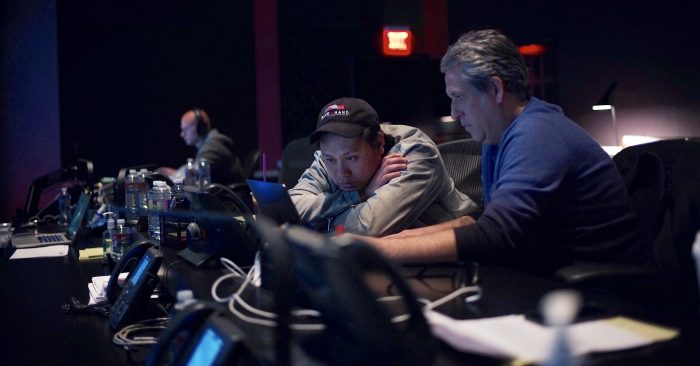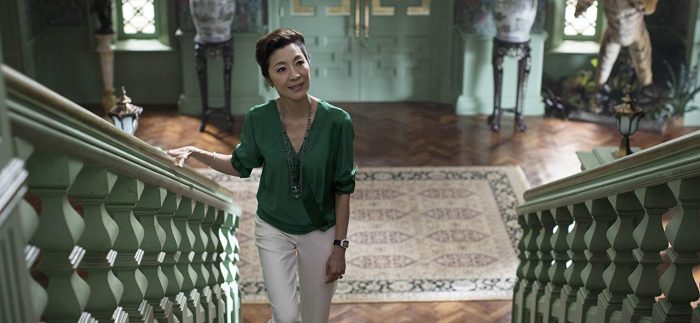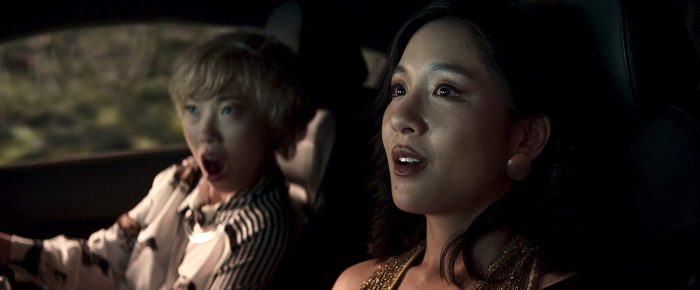'Crazy Rich Asians' Editor Myron Kerstein On The Universal Messages Of Rom-Coms And Mahjong [Interview]
Myron Kerstein wants audiences to know that romantic-comedies are back. The editor of Crazy Rich Asians is no stranger to the genre, having cut together rom-com staples like Garden State and Nick and Norah's Infinite Playlist, but in the aftermath of Crazy Rich Asians, it feels more important than ever for Kerstein to reiterate that.
Kerstein sat down with /Film to talk about the outrageous success and cultural impact of the first major Hollywood film led by an all-Asian cast in 25 years. Aside from being a watershed moment for Asian-Americans, Kerstein sees Crazy Rich Asians as an opportunity for Hollywood to turn a new leaf for not just representation, but the rom-com in general.
"I just hope people go see romantic-comedies," Kerstein said. "And hopefully they'll embrace races that haven't been there on the screen too much that have basically been there all along."
"I think this is just the tip of the iceberg," he added, "and hopefully Hollywood's gotten the message."
 What was your reaction to the major box office success and pop culture impact of Crazy Rich Asians?
What was your reaction to the major box office success and pop culture impact of Crazy Rich Asians?
It's pretty overwhelming, right? Who would think that anyone would ever see your movie alone, let alone a crossover hit. You just never expect anyone would see any of your movies when you're making them. And then to have such a — you're hoping that at least an audience would go see your film, but to have it cross over and then have so many people deeply affected by it, is what you hope for in everything that you make. But it was pretty remarkable.
I went to go see the film — it actually came out on my birthday. It was so strange because the film was supposed to be released two days later but then they decided to move it up to a Wednesday, which was my birthday. So I went to go see it with my friends but I ended up sitting alone next to this little boy and his mom, and they were both Asian. And throughout the course of the film, the little boy giggled and weeped throughout the movie and I thought, wow this is a pretty amazing experience right here. To have this affect anyone who might have otherwise never seen something like this represented to them. And if that doesn't encapsulate the feeling of what this film means to so many people, I don't know what does.
Yeah I know I cried when I went to see it with my family. And I was surprised that my uncle was crying during several of the scenes during Crazy Rich Asians. So were you aware of that importance of the film going into it when you went to work on the project?
I knew the stakes were high, and that the representation of this community hadn't happened in 25 years in a major Hollywood movie but I didn't know it was going to affect people so deeply. I knew that the script felt very important to me, because there were scenes that I related to and I'm not Asian [laughs]. But I knew that the themes were very universal and just to see that the reaction would be so widespread was pretty satisfying. Again, you just never know once you start going into these things how they're going to turn out.
You have a hunch that the mahjong scene might be deeply felt, or the scene with Rachel and her mom might be deeply felt, but you don't really know until you start screening it and you're like "Okay, yeah I guess what I experienced is what everyone else is feeling as well."
Let's talk about that mahjong scene. Jon Chu has described the mahjong scene as a "ballet" and choreographed as a fight sequence like something out of Michelle Yeoh's own movie Crouching Tiger, Hidden Dragon. How did the editing help transform a tabletop game into something that dynamic?
It's funny, I've heard Jon say that as well about choreographing that scene to me and to others, but he didn't tell me at all how he wanted that scene to be constructed. I think he had the confidence in what he had planned, that I'll figure it out while I edit, but he also wanted to see my take on it. I also did not know at all how to play mahjong. [Laughs.] When they were shooting B-roll for it, I heard Michelle and Jon talking over the shots — they often record sound when they're shooting B-roll — and eventually described "this piece as to go there, this piece has to go here," and I slowly learned how to understand how the game is supposed to be play. And of course I'm not going to have Jon or Michelle Yeoh narrate the scene so I had to find a way to tell the same visual story with the pieces and using all the rules of this game without understanding what was going on. You just needed to understand that this piece represented Nick, and that she was going to sacrifice Nick because she has her own pride...
Keep her own dignity?
Yeah, her own dignity. And I think as far as the other kernels of the scene, I think
Constance did this wonderful job with her performance in this scene. Sometimes you find little kernels of things to build a scene out of, and there's this wonderful line that I think really encapsulates everything about the scene, where she goes, "I'm not leaving because I'm scared or because I think I'm not enough. It's because maybe for the first time in my life I know I am." To me that was the whole scene right there, I just needed to built tit-for-tat as Eleanor and Rachel [confronted each other]. And that being sort of our climax, ended up making the scene.
I know that Michelle Yeoh and Constance Wu both had a lot of input into this scene, did that affect how you edited the scene at all? Again, I didn't know any of this! [Laughs] I just knew that the scene found its way to me over many revisions in the script. And I could tell something was going on, they kept rewriting the scene over the course of the shoot. But no one was telling me that Michelle has some notes or Constance has notes, I just see the revisions coming in, but you can see a more deeply evolved script over the course of time where both [Eleanor and Rachel] are basically trying to say what's important to them and why they're doing things they way they're doing them. Sometimes you read a script, you're like, "Okay it doesn't matter what these lines are according to the actors or to the characters, and I can cut x,y, and z out of it." But this was a scene where I don't think I cut a single line, I think it's beautifully written. Can you recall at all the original scene as it came to you in the screenplay and the final scene through all that it went through?
Can you recall at all the original scene as it came to you in the screenplay and the final scene through all that it went through?
It just felt a little bit thinner in the beginning. Like it felt like a scene where, from what I remember, that Rachel and Eleanor were going to meet, and Rachel was going to tell her "I've decided not to marry your son." But I think it built outward from that where each of them had more to say and it was up to both of them to basically articulate that each of them are so foreign to each other that they'll never be able to get along.
That first montage really sets the tone for the film, with the playful graphics, the split screen, and the bouncy music and pace. What went into crafting that scene?
That process of making that sequence probably took about four months. It first started with about two lines in the script and of course many pages in the novel, s we said, how do you make it into this epic set piece? And Jon had basically storyboarded a page-long storyboard sequence with how he wanted the things to sort of act with each other. But we didn't know what the text bubbles would say, how many images there would be. So I took the storyboards and basically crafted maybe a two-minute that just really loosely split screens with some of the footage that had already been filmed. But it was basically just a sketch. And we considered at one point to maybe even scrap the sequence, because how are you going to make this work? But then we decided, let's give it a shot, let's hire a really amazing graphics company to help flesh this out.
So we hired this company Aspect, which is lead by John Burkowitz. With him and his team of artists, Jon and I slowly started building this sequence where one character affects this one, what will the bubbles look like, what color will the bubbles be, what image should we go to next? The company started making this almost Disney-esque animation, and we really liked that so we said, "let's do more of those." Slowly we started building step-by-step this really immaculate sequence. Then we started attempting ... anything musically that could work with the sequence. We ended up landing on this big-band quality, which we first drew from around 1941 with John Wayne, and Brian Tyler, our composer, added his stamp on it. And slowly we started building something that has a retro feel but modern at the same time. We wanted something that sounds timeless.
Were there any other sequences that came about like that?
The Hawker sequence was really challenging but very rewarding, because it was a section of the film that I knew I was going to love. But it was intimidating because, how do you relay the sort of specific cultural place? And let people get really hungry, and introduce these crazy friends? That was one of the few times I actually went down to set and basically spent the whole night with them shooting the sequence. I was like, "This place is just chaos and madness," and we have to connect all of that.
Jon shot this sequence in the middle of a wide market with his actors buried in the middle of it. In the mean time he had a B-camera crew shooting all these stalls of the food we'd prepared, and when he gave it to me, it was like, "Okay go, make something out of this." [Laughs.] Part of me was like, okay this is going to be great, but the other part is asking, "How do I possibly intercut this confrontation, them meeting friends, essentially us falling in love with Rachel and Nick, and making us all feel real hungry?" That was a real challenge but then it came together really beautifully.
Other sequences that were challenging was the bachelorette/bachelor party sequences. That was probably a place where we cut and recut the most over the course of eight months. We just couldn't figure out who cared. We've established this place, this wonderful world where we meet all the cousins and the aunties, and then we're going to leave them and spend time with the new money, the younger crew. I didn't know if the audience could sustain being away from that main storylines for 20 minutes, 30 minutes. So again, there were sections of that, that don't make the movie. There was a huge set piece where we spent time on the freighter ship with the girls, and alcohol, and mayhem, and realizing that we only needed a little bit.
There was the conversation between Colin and Nick intercut with Rachel at the bachelorette party, that were two things that were never intended to be intercut together. And those were just ways of us trying to find the right balance. To tell the story we needed to tell, but also to get to that in such an efficient way. Especially in the script, you think "We're going to have so much fun here," but it's only when you get to the screen when you realize you could tell this in a much more elegant way to tell a story in this section and then find our way back to the main plot line.
And then, of course, the wedding. I remember the producers saying, "You know Jon wants to shoot this sequence where water runs through the middle of it and I don't know if he's going to be able to pull this off with the budget and the time..." Then Jon is whispering in my ear, saying ,"It's going to be amazing. We're going to do it to this classic Elvis tune, and the only thing we only have to remember is that it's two people falling in love together." So I took that and said, okay this is the main focus of this wedding scene.
That's another scene when my family members I was watching with started crying to it, because it's such an emotionally-driven sequence despite being incredibly lavish.
It's almost like a satire in that scene. You want to laugh at how crazy it is, but because it ends up being about Rachel and Nick and that focus on how they're going to overcome everything in this moment, and how they truly are ready to spend the rest of their lives together — that juxtaposition really makes you accept the grandeur and insanity of this wedding and just fall in love with them all over again.
 What was your favorite sequence to edit?
What was your favorite sequence to edit?
I mean, mahjong was probably my favorite sequence without a doubt. The wedding, the hawker markets, the food montages, the sequence in Tyersall Park where Rachel meets Eleanor for the first time. To me, I knew that the film was always supposed to feel like Asian Gatsby. But that section of the film really encapsulates all of it. There are so many sections where you meet the Amma, you meet the cousins, you have the food preparation downstairs, there's Jasmine Chen singing love stories. And we have this beautiful scene between Eleanor and Nick where she's basically asking, "Is Rachel going to be taking my son away from me?" There's so much that's going on in that section of the film. You have this really funny moment where Peik Lin and Rachel see the house for the first time. It's just this Cinderella and fish-out-of-water story, and a mixture of great tones and great music. To me, that section really encapsulates the film the best.
Are you on board for the sequel too?
Hopefully! We'll see. I do all this at the pleasure of Jon. But I will hopefully get to cut all of these romantic-comedies, and if we make three of them, that'd be amazing.
This interview has been edited and condensed.
